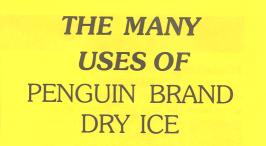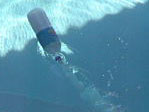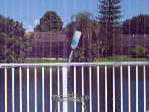You too can make a rocket out of a water bottle and a chunk of dry ice.
Dry-Ice Rockets
with Jay Wilson
August 2003

DISCLAIMER: This document describes dangerous experiments with expanding gases—BOMBS, in short. Do something wrong, and you could lose digits, put your eye out, etc. This could happen even if you do everything right. The world is a dangerous place, and Eiki Martinson takes no responsibility for anything that happens to you in it. In fact, why don't you do us both a favor and just stop reading this? Get into bed and pull the covers over your head. There ... much safer.

... including some which the Penguin Brand never authorized or even imagined. Now for the fun bit (honestly, it's really not that dangerous). Many of you may remember playing as children with water rockets, which were billed as a safe alternative to Estes-style chemical rockets. You pressurize these with a small air pump; when released, the compressed air drives the water out the nozzle and, as Newton taught us, the rocket will shoot into the air. But really, who wants to do all that pumping? Especially when more exciting (less predictable!) methods are at hand?
While playing with some dry ice intended for special effects purposes, Jay Wilson and I stumbled on an interesting discovery: a water rocket could use CO2 instead of air, and the dry ice would do the pressurization for you. Better still, the 'rocket' itself is radically simpler—in fact, you probably already have one in your house, or, if not, you can get one out of the trash. Here follows the technique:
The rocket itself is no more than a water bottle, of the 'sport' variety, with a nozzle at the top that you pull upwards to open. I believe the Dasani brand now uses a rotary type of nozzle instead, but I expect this will not work. Our tests were conducted with Nestle company brands (which all use the same bottles) such as Zephyrhills, Deer Park, or Poland Spring. Unscrew this cap and put a small amount of cold water into the bottle (maybe 1/5 full) followed by some pieces of crushed dry ice. Quickly screw the cap back on, making sure that the pop top is pushed down or in the closed position. Place the bottle upside down on some kind of stable launch platform which is sure to keep the bottle upright. The timing is quite unpredictable, so take a step back and don't let the thing poke your eye out.
This works as a rocket because the dry ice will boil away when it contacts the water, producing carbon dioxide gas which pressurizes the bottle, forcing the water down. When enough pressure builds up, this force will push open the pop-top from inside—releasing the water through a very servicable rocket nozzle.
How did Jay and I discover this? Well ... of course we were trying to blow the bottles up instead. The first one was pointed upward, the bottle sitting there in the normal way. Instead of the expected polyethylene shrapnel, however, we observed the top of the bottle pop up and emit a jet of gas—an obvious effect when you think about it, but quite surprising at the time. Needless to say, applications of this phenomenon were quickly investigated.
The two videos above (beware: they are about one half megabyte each) are the results of our next experiments—the puerile guffaws and evil snickering say it all! Floating the bottle on its side in the pool makes it a rocket boat of sorts. It skims over the water, and might even fly briefly. In these trials the thrust is provided mainly by the escaping CO2, as the water in the bottle may not completely cover the nozzle.
Here a flower-stand is pressed into launch-pad service; there is a hole in the center that accepts the nozzle and holds the bottle relatively upright. Our first shot (leftmost video above) was one of the highest and straightest of the day. In contrast, the second video provides ample evidence of the instability of an upside down water bottle!
Many of these experiments attempted to optimize the various parameters of the rocket: such variables as the volume of water, the volume and consistency (large chunks, fine powder, or anything in between) of the dry ice, even the "tightness" of the nozzle. Some early attempts tried to minimize the volume of water, to reduce the weight of the bottle when it takes off. However, it was determined that the gas does not so much propel the rocket by itself as it forces the water out the nozzle—the heavier water is the effective propellent, just as in those air pump water rockets. If the water volume is very low, it shoots out almost immediately. However, although more water makes for an extended thrust, it also adds to the mass of the bottle.
Here we see a launch with the bottle almost 1/2 full, which is why the water jet lasts so long and the rocket seems to hover in place. Long hovering is not really the way to get a high shot as the unstable bottle has more of a chance to go horizontal that way. The second video shows one of the more successful launches of the day—it ended up on the roof! We used less water than the previous attempt, filling the bottle approximately 1/4 full.
Finally, we were able to take still photographs of the the rocket during takeoff, using a feature of my camera that allows the user to hold down the shutter to take up to five continuous shots. It was, unfortunately, not a very straight launch. If you have some mechanism by which to flip through these images quickly, take advantage of it—it makes for a nice slow motion animation.

Actually, maybe they did imagine some of these experiments! This warning and the first image ("The Many Uses of Penguin Brand Dry Ice") came from a curious pamphlet offered alongside the dry ice at the supermarket. Needless to say, rocket propulsion was not among the many uses.







